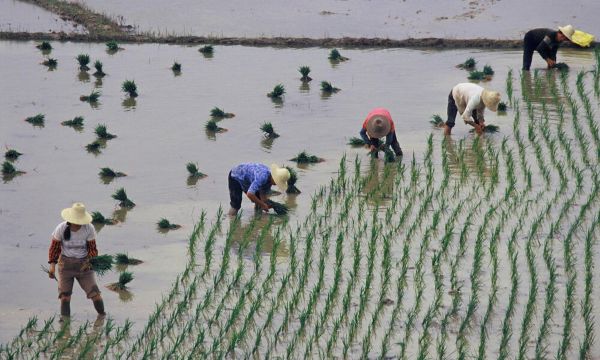Rice varieties are primarily grown in warmer climates around the world. It is the primary food staple for between half and two-thirds of the global population. In Asia, it feeds 90%.
When growing rice there is a downside. Rice produces significant greenhouse gas (GHG) emissions. How significant is illustrated in the subtitle of a recent article that appeared on the World Wildlife Fund site. It says, “Side of rice, hold the methane.” If only we could.
Rice Has A Methane and Nitrous-Oxide Problem
When tracking the rise in atmospheric temperatures over the last three decades, carbon dioxide (CO2) isn’t the prime suspect. It is methane (CH4), a short-term potent GHG with a greater warming impact over 12 to 14 years than CO2. Rice farming is a big contributor producing 12% of global CH4 emissions and 1.5% of our total human contributions.
Traditional flooding of paddy fields is the main cause responsible for between 50 and 80% of total CH4 emissions coming from rice cultivation. GHG-emitting bacteria thrive in flooded fields. Other than cranberries, I can’t think of another crop that begins its growth cycle under water. Rice cultivation because of this early submergence produces up to 5.7 times more GHGs than wheat and corn.
Rice also produces nitrous oxide (N2O). Its cultivation contributes 11% of total agricultural N2O emissions. N2O like CO2 is a long-lasting GHG and is 300 times more potent than CO2 and remains in the atmosphere nine times longer than CH4.
Almost all varieties of rice are grown in paddies. The rice needs the bacteria in the water to release soil nutrients to support plant growth. That’s why scientists are trying to identify the organic compounds called root exudates that are produced by the roots of rice plants. If the worst CH4-producing compounds can be isolated, then it becomes possible to develop a new rice variety that produces less of the GHG.
Finding Ways to Produce Rice With Less GHGs
There are two approaches to developing rice varieties that belch fewer GHGs. The first involves identifying characteristics in rice plants that produce less CH4 and through selective breeding produce low-CH4 output. The second involves genetically modifying rice to eliminate the traits that produce CH4-emitting organic compounds.
Cross-Breeding Produces LFHE Rice – A breakthrough for the former method has been published in the February 3, 2025, scientific journal, Molecular Plant. The published research reveals that LFHE rice produced through conventional cross-breeding produces 70% less CH4 compared to other varieties.
LFHE rice has been tested in field trials in China with yields of 8.96 tons per hectare. Compared to average global rice yields of 4.71 tons per hectare in 2024, this represents a more than 90% improvement in yield which for countries facing food insecurity is significant.
Genetically Modified Rice Eliminates CH4 – Rather than selective breeding, SUSIBA2 rice was developed through genetic intervention in 2015. A barley gene insertion into the rice plant has produced two important effects: CH4 reductions of 90% and crop yields in Chinese test fields comparable to those for LFHE rice.
Finding Ways to Accept the Benefits of GM Rice
Many countries, however, have barred GM crops from being grown or sold. This resistance by governments to GM crops boggles my mind and that of many agronomists and geneticists.
Consider the case of golden rice.
Golden rice is a GM rice version that organizations like Greenpeace have protested against. Developed in 1999, GM golden rice involved inserting genes from daffodils, corn, and a soil bacterium to bind Vitamin A within the rice without affecting it in other ways. It significantly increased beta-carotene production in the plant and gave the rice a golden-yellow look.
Golden rice was developed to address Vitamin A Deficiency (VAD) common to the poorest people of Africa and Southeast Asia whose diets were heavily rice-dependent. VAD, states the World Health Organization (WHO), affects 250 million people globally, 40% of them being children under the age of five living in the Developing World.
UNICEF statistics show VAD is responsible for between one and two million preventable deaths annually. Adding Vitamin A to the diet is critical. Without it, the immune system, particularly of babies and young children is compromised.
VAD is the leading cause of childhood blindness on Earth affecting 250,000 to 500,000 children annually. Half die within 12 months of losing their eyesight.
Yet GM golden rice, 25 years after development, has just been banned in the Philippines and currently is under threat of being banned in Bangladesh. These bans are counterintuitive considering that a 2019 nutrition survey done in the Philippines noted that 15.5% of Filipino infants and children aged six months to five years suffered from VAD. The Philippines provided no VAD mortality figures. A 2012 survey of preschool-age children in Bangladesh indicated 20.5% suffered from VAD with 30,000 going blind each year and at least half dying within weeks of the first blinding episode.
Let’s hope that countries that are as heavily rice-dependent as the aforementioned two are more science-aware of the benefits of new breeds of rice including GM varieties that address food insecurity and dietary deficiencies.









